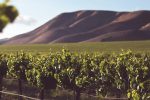The Wines of Chablis and the Grand Auxerrois by Rosemary George – Review

By Paul Howard
Chablis – it’s the best known white wine. And not just in the UK, which is still its biggest market, but worldwide. It’s so famous that many don’t realise it’s a Chardonnay from a small group of villages in northern Burgundy. Even though it’s a unique expression, Chablis is far from being one wine. There are four quality levels, 450 (ish) producers and a range of terroirs and winemaking styles.
I’ve visited Chablis nearly every year for the past thirty years. It’s become revived and prosperous, almost doubling in size. During this time, the Chablis hinterland, referred to as the Grand Auxerrois, has also flourished anew. Though much less well known, it deserves coverage and makes a happy hunting ground for a variety of superb value red, rosé, white and sparkling wines.
When the first edition came out in 1984, it became my reference book in residence as I explored Chablis and the nearby towns and villages. These days, I sometimes meet the children of the producers I first met. They have taken over, some maintaining traditions, others exploring new ways of doing things. It’s a sobering thought, a reminder that even if we think we know wine or a place it renews and refreshes with each passing vintage. Hence, this completely revised book is timely.
Rosemary George’s book is well set out and is a compelling read. She weaves the complex story of Chablis well, and I particularly enjoyed the detailed descriptions of its chequered history since Roman times. Chablis has undoubtedly had its ups and downs throughout the centuries. Looking at this prosperous area today it’s hard to believe that post-war the vineyards were close to disappearing. There are good explanations about the differences in quality levels (Petit Chablis, Chablis, Premier Cru and Grand Cru) and how these became created.
“Winegrowing here remains high risk”
The climate here for winegrowing is marginal, just like in nearby Champagne. Describing how growers manage the risks of devastating spring frosts is, for me, one of the most important and sometimes heroic aspects of appreciating Chablis.
Indeed, while climate change may well threaten Chablis in the future, the frosts of 2017 are a timely reminder that winegrowing here remains high risk. Furthermore, I particularly welcome the down-to-earth exposition on Chablis as a business rather than just a description of only the more romantic aspects of the subject – other wine writers, take note!
However, the central part of the book is the “Who’s who” producer sections. These are pen-pictures of many of the most prominent estates. Chablis (and its nearby villages in the appellation) get 86 of these, while the Grand Auxerrois has a further 44. The Chablis entries begin with the La Chablisienne cooperative, which has 25% of production and a vast range of wines. It’s where any newcomer to Chablis should begin. From there, she visits producers large and small in the Chablis appellation, including the titans of Raveneau and Dauvissat. Each has its philosophy and story to tell.
 Meanwhile, the Grand Auxerrois offers considerable variety and choice. You’ll find red wines from Pinot Noir, Gamay, and the rare César. Whites meanwhile include Aligoté, Sacy, Pinot Gris, Pinot Blanc and the Sauvignons (Vert, Gris and Blanc) as well as Chardonnay. Those thinking that Burgundy has only Pinot Noir and Chardonnay should spend time here, far away from the Cote d’Or.
Meanwhile, the Grand Auxerrois offers considerable variety and choice. You’ll find red wines from Pinot Noir, Gamay, and the rare César. Whites meanwhile include Aligoté, Sacy, Pinot Gris, Pinot Blanc and the Sauvignons (Vert, Gris and Blanc) as well as Chardonnay. Those thinking that Burgundy has only Pinot Noir and Chardonnay should spend time here, far away from the Cote d’Or.
“A reliable and thorough guide”
If you explore these areas, you’ll encounter many highlights. For example, the lovely medieval city of Auxerre, the calming river landscapes of the Yonne, and cherry blossom at Irancy. Or visit the Abbeys at Pontigny and Vézelay and the deep ancient cellars in St. Bris.
The book finishes with a short bibliography and a useful glossary of french tasting and winemaking terms. There’s also a description of harvests, production figures and dates going back to 1870. They do point out how much this area suffers from vintage variation. Finally, if there is any doubt about Chablis’ ability to age, there’s an extraordinary encounter with a Chablis from 1846.
Reading this book brought happy memories flooding back. Seeing the AJ Auxerre football team beat PSG; buying lace at Chablis Sunday market; or being proudly shown an ancient wine-stirring stick by Jean-Pierre Colinot. Moreover, drinking Crémant fizz from Caves de Bailly-Lapierre by the River Yonne while spying a motionless Heron. Magical: watching thousands of vineyard heaters burning on a starlit spring night.
To sum up, use this book as a reliable and thorough guide to the wines and producers, of course. More importantly, use it to create happy moments of your own.
Now, you’ll have to excuse me. I have a 1999 Chablis Montée de Tonnerre Premier Cru and a large piece of Chaorce cheese waiting.
‘The Wines of Chablis and the Grand Auxerrois’ by Rosemary George is published by Infinite Ideas, paperback £30










